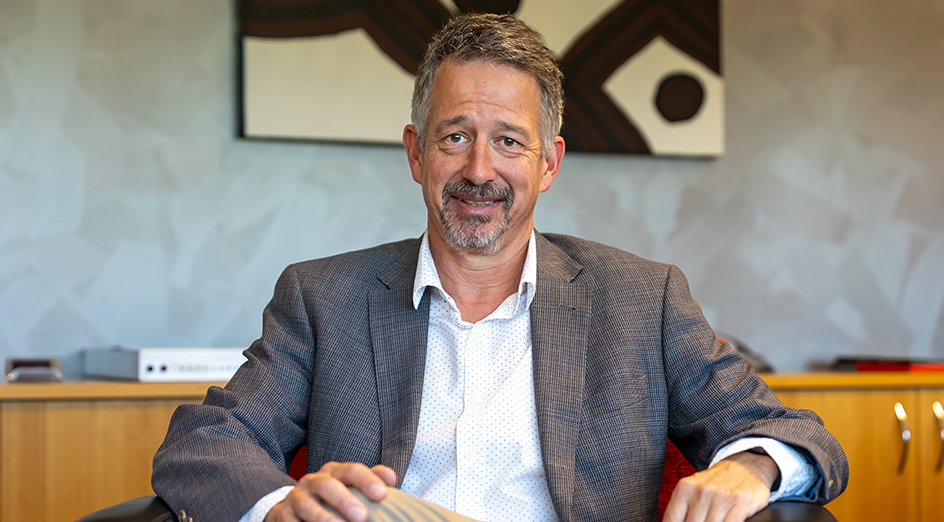New Executive Director Joins ICRAR at University of Western Australia
Born on the day of Neil Armstrong’s historic moon landing, it’s perhaps not surprising that new Executive Director of the International Centre for Radio Astronomy Research (ICRAR) Professor Simon Ellingsen has had a lifelong fascination with space.
“Mum was in labour and the nurses were coming in and out talking about what was going on and so she missed out on seeing it live – since I can remember I’ve known that particular fact, but I’m not sure what impact it had,” he smiles.
Whatever the effect of that early brush with celestial history, Simon brings a wealth of expertise to his new role at ICRAR, the joint venture established between UWA and Curtin University in 2009 to support Australia’s bid to host the world’s largest radio telescope, the Square Kilometre Array Observatory (SKAO).
With a PhD in astrophysics, he’s consistently demonstrated a passion for advancing the frontiers of radio astronomy, with his major areas of research the formation of massive stars, in particular through the study of interstellar masers, the natural microwave versions of lasers found in space.
 Image: New ICRAR Executive Director Professor Simon Ellingsen.
Image: New ICRAR Executive Director Professor Simon Ellingsen.
Before joining ICRAR Simon was Dean of the School of Natural Sciences at the University of Tasmania, having grown up in the seaside town of Ulverstone on the island’s north-west coast, after emigrating with his parents from the UK when he was five.
At UTAS he played a central role in expanding the University’s radio antennas from a single antenna to seven across five sites in Australia, the only continental-scale radio interferometry array owned and operated by a university anywhere in the world.
While completing his Bachelor of Science (Hons) project, he mapped radio emissions from Centaurus A, the Magellanic Clouds, and the centre of the Milky Way and his PhD focused on radio spectroscopy, discovering many 6.7 GHz methanol masers and using them to study stars’ formation.
His research led to the identification of new star formation regions and has been pivotal in galactic surveying, resulting in the discovery of numerous new high-mass star formation regions. Techniques he continues to use to solve astrophysical problems to this day.
On his new position he says: “If I’d had to write my ideal role, this probably would have been it, because it gives me the opportunity to combine the two things I’m most passionate about in my work life.
“ICRAR has a clear goal – to play a crucial role in the international SKA project by attracting leading experts in multiwavelength astronomy, astrophysics, engineering, and data-intensive astronomy.
“I’ve been involved with radio astronomy since 1991 when I started my honours at UTAS, and the Square Kilometre Array is the biggest international project in radio astronomy – the opportunity to be more closely involved couldn’t have come at a better time.”
He sees one of his biggest challenges as maximising the work being done in scientific research at ICRAR and in translating the innovative technologies into direct and tangible benefits for the broader community.
“The SKA is a two billion euro project so it had to be international, but what that means is the people who pay for it are taxpayers and it’s critical that they see the benefits – not just the knowledge that’s generated and the amazing science, but also in the spin-offs and the technological benefits,” he says.
“We have to translate to the average person in the street and that’s the role for places like ICRAR. The hardware, for example, that has to be developed for the SKA needs to be so specialised that it pushes boundaries and this then flows through to consumer benefits.
“One really obvious example of this is the cameras we have in our phones. Essentially the technology for that was developed for optical telescopes, for looking at the stars. That’s why when you use your iPhone you can take some amazing images of the night sky if you know what you’re doing.
“A lot of the data work that we do also pushes the boundaries and this can also then be applied elsewhere.”
The other aspect of the job that Simon, who is father to three grown-up children with wife Kristi, is looking forward to, is people leadership.
“The thing that brings most of the staff and the students here to ICRAR is they want to do the research and have the opportunity to be involved in things like the SKA and utilising the world’s leading infrastructure to push the boundaries of knowledge,” he says.
“That’s what motivates most of our staff and students most of the time and it’s exciting to be part of that as well, because that’s what got me started and I understand that.”
In whatever downtime he has, Simon says he and Kristi are looking forward to exploring WA’s many beautiful beaches and everything else the state has to offer.
“I’m not going to miss the Tasmanian winter that’s for sure,” he laughs. “I grew up just a few minutes from the beach in Tasmania and the opportunity to get to the beach more easily and more often here will be nice.”

